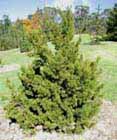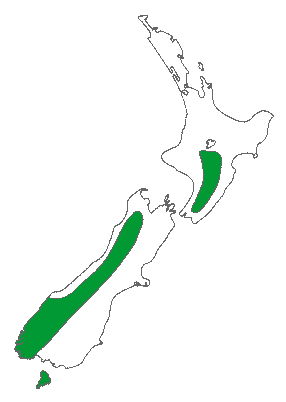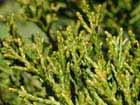
Mature tree, 4.5 m tall, on Mt. Ruapehu, New Zealand [Trevor Hinchliffe].

Cultivated tree, Mt. Tomah Botanical Garden, Australia [Trevor Hinchliffe].

Adult foliage from a tree on Mt. Ruapehu, New Zealand [Trevor Hinchliffe].

Distribution map (Metcalf 2002).

Foliage on tree at Mt. Tomah Botanical Garden, Australia [Trevor Hinchliffe].

Bark on a tree on Mt. Ruapehu, New Zealand [Trevor Hinchliffe].

Conservation Status

Halocarpus biformis
(Hooker) C.J. Quinn 1982
Common names
Yellow pine (Salmon 1996, Metcalf 2002).
Taxonomic notes
Syn: Dacrydium biforme (Hooker) Pilger 1903; Podocarpus biformis Hooker 1843; Dacrydium colensoi Kirk [not Hooker] f. 1854, misapplied name (Quinn 1982). A possible natural hybrid, H. biformis × Lepidothamnus laxifolius, has been reported in New Zealand (Dallimore et al. 1967). Type locality: Dusky Sound; type: K, Menzies (Allan 1961).
Description
Dioecious small tree up to 10 m tall and 60 cm dbh, with spreading branches and a rounded crown; in exposed settings (such as alpine areas), it often forms a tight, rounded, cypress-like shrub. Bark silver-grey, peeling away in small thick flakes to reveal a reddish-brown inner layer. Branches stout, clothed with persistent leaves; branchlets 3-4 mm diameter, 4-sided. Has distinct juvenile and mature foliage, although branchlets of mature trees often revert to the juvenile form. Juvenile leaves spreading, linear, 10-20 × 1.5-3 mm, narrowed into a short, twisted petiole; midvein usually distinct; stomatal lines evident. Mature leaves scale-like, densely imbricate, closely pressed, 2 mm long, blunt, very thick with translucent margins, prominently keeled on the back. Pollen cones solitary, about 4 mm long, at the tips of branchlets. Ovules ovoid, compressed. Epimatium adnate to carpidium at base, coriaceous, surrounding the pendent inverted ovule; integument membranous. The seed (which appears to form at very irregular intervals and takes about twelve months to reach maturity) is solitary or rarely in pairs, oblong, blunt, striate, compressed, 2-3 mm long, in an orange aril. Wood is pink and sweet-smelling; tight-grained, it is possibly the most durable of New Zealand native woods (Allan 1961, Dallimore et al. 1967, Salmon 1996).
The adult scale-like foliage evidently bears a close resemblance to that of the other New Zealand scale-leaved forest conifers, Halocarpus kirkii, Lepidothamnus intermedius, and Manoao colensoi, and I have not found any source describing how these foliages can be distinguished. Fortunately all of these species have characteristic juvenile foliage.
Distribution and Ecology
New Zealand, from the volcanic plateau of the North Island south to Stewart Island, at elevations from sea level to 1,400 m. Rare in the north, it is more plentiful in the south, often occurring in small local stands on rich soils in high-rainfall areas. On the southern slopes of Mt Ruapehu it is found occasionally in the forests and, above the bush line, around bogs with H. bidwillii (Salmon 1996). Within its range, mean annual temperature is 8.8°C, with an average minimum in the coldest month of -0.6°C, and a mean annual precipitation of 3009 mm (Biffin et al. 2011, Table S5).
Hardy to Zone 8 (cold hardiness limit between -12.1°C and -6.7°C) (Bannister and Neuner 2001).
Remarkable Specimens
Wardle (1991), citing earlier work of his own, states that the species can attain ages of 1000 years. I have no further information about this date.
Ethnobotany
See Conifers of New Zealand for a review of the historic role of forests in native and European cultures of New Zealand.
The wood was formerly used locally for building purposes, railway sleepers, fence posts, and other work (Dallimore et al. 1967). As with other native New Zealand trees, it is now largely protected from harvest. The species has been investigated for use in dendrochronology (Norton and Palmer 1992), but I cannot find that it has been so used.
Observations
I have seen it on Mt. Ruapehu in New Zealand's Tongariro National Park. Some plants can be seen growing in alpine scrub in close association with Halocarpus bidwillii along the Taranaki Falls walk starting at Whakapapa Village, but the most extensive stand I found was in a memorable subalpine elfinwood on the track up Hauhungatahi, a subsidiary cone west of Mount Ruapehu, where it grew densely with Libocedrus bidwillii. To reach this stand, drive 5.5 km south from the highway junction in National Park to the tiny hamlet of Erua and park near the railroad tracks. Follow the tracks about 250 m south to where a small, weathered sign says 'Track' and follow it. The track heads almost continuously uphill, starting in a flax thicket and then, in the forest, passing progressively through elevation zones dominated by rimu (Dacrydium cupressinum), matai (Prumnopitys taxifolia), montane totara (Podocarpus laetus), kaikawaka (Libocedrus bidwillii), yellow pine (Halocarpus biformis), mountain toatoa (Phyllocladus alpinus), bog pine (Halocarpus bidwillii) and pygmy pine (Lepidothamnus laxifolius). The highest subalpine forest has a dense forest of mature Libocedrus bidwillii and Halocarpus biformis only 5-7 m tall, with juvenile plants in the understory.
Remarks
The epithet refers to the two distinct leaf types encountered even on mature trees.
Citations
Allan, H. H. 1961. Flora of New Zealand. Volume I, Indigenous Tracheophyta. Wellington: R.E. Owen Government Printer.
See also
Hooker. 1843. Ic. Pl., t. 544; Ann. Bot. (1934) 48, 9.
Kirk. 1889. Forest Flora of New Zealand (as D. colensoi).
Wardle, P. 1991. Vegetation of New Zealand. Cambridge: Cambridge University Press.
Gymnosperms of New Zealand.
The New Zealand Plant Conservation Network, accessed 2010.11.22.






